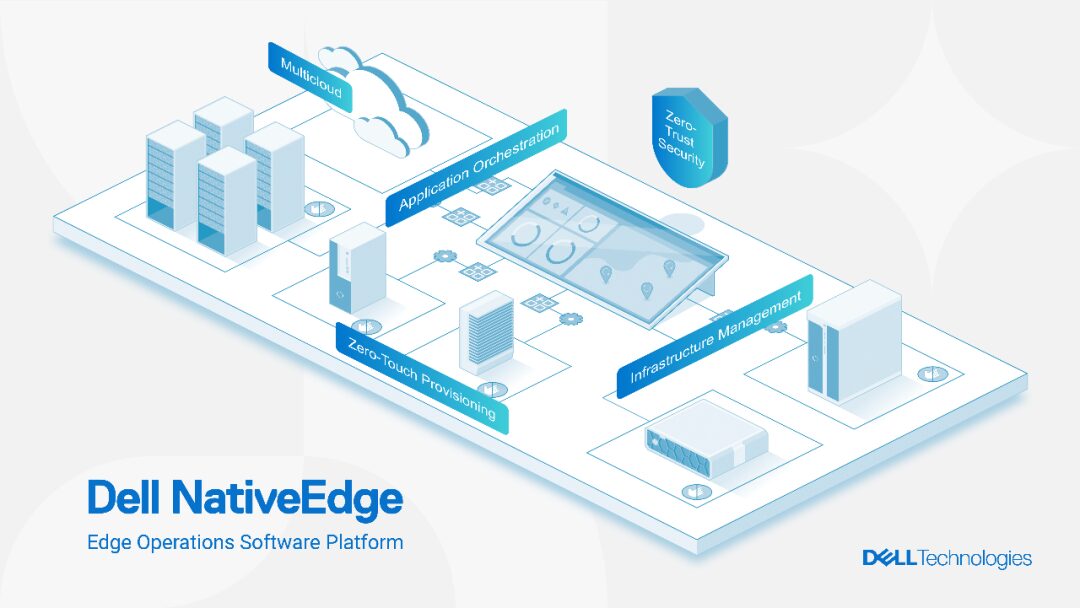
Industry forecasts indicate that by 2030, the global potential market size for edge computing will reach $445 billion, with a compound annual growth rate of 48%. Undoubtedly, edge computing is another new high ground for IT vendors to compete for! Who is quietly researching and strategizing? Who will stand out?
Commitment to Opportunity in Edge Computing
As the saying goes, “Before the army moves, provisions must be in place.” Recognizing the potential of edge computing, Dell Technologies announced Project Frontier last year, focusing on developing a secure management platform for enterprise-level edge computing. At this year’s Dell Technologies Summit, Dell officially announced that Project Frontier has begun commercial implementation, and Dell NativeEdge will become a powerful tool for Dell to penetrate the edge computing market.
 Yang Jie, Global Vice President of Dell Technologies and General Manager of Pre-sales Systems Engineering for Greater China
Yang Jie, Global Vice President of Dell Technologies and General Manager of Pre-sales Systems Engineering for Greater China
Yang Jie
According to Yang Jie, Global Vice President of Dell Technologies and General Manager of Pre-sales Systems Engineering for Greater China, since last year, Dell Technologies has formed a virtual team across various business departments specifically targeting the edge computing market, gathering experts from different departments to strategize for the promotion of edge computing business. Given the wide range of scenarios covered by edge computing, almost all of Dell’s existing product lines are involved, including servers, storage, terminals, and dedicated edge devices such as Gateways. “We aim to gather professionals from all fields to break through some edge computing-related scenarios on the market side and client side, establish a number of typical cases, and promote the comprehensive implementation of the edge computing strategy from points to lines and then to surfaces,” Yang Jie said.
For Dell Technologies, products and solutions are the core and foundation of its edge computing business. It is understood that Dell Technologies will further optimize edge computing hardware solutions to meet the needs of different edge scenarios, such as designing smaller, low-power edge servers and edge storage devices to adapt to the limited space and power resources at edge nodes. In terms of networking, Dell Enterprise SONiC is a unified network operating system that implements cross-cloud, core, and edge use cases, suitable for multi-vendor platforms, better supporting connections from edge to cloud. Dell Technologies’ latest edge switching platform product line, the Dell PowerSwitch E series, features streaming telemetry and user container support, enhancing visibility and programmability while providing a more powerful and scalable hardware platform that supports enterprise SONiC for edge networks.

In terms of software, from Project Frontier to Dell NativeEdge, it represents a process of Dell Technologies’ edge computing strategy from vision to realization. Dell NativeEdge is currently the only edge operation software platform in the industry, with its main value being the support for large-scale secure device onboarding, remote management, and multi-cloud application orchestration. Specifically, it provides edge computing infrastructure, securely addressing the edge computing challenges faced by customers; offers a multi-cloud environment that allows customers to efficiently manage edge infrastructure using various tools, even remotely; and facilitates flexible orchestration of infrastructure to ensure that various applications running on the infrastructure meet edge computing needs.
After nearly two years of continuous exploration and practice, Dell Technologies has reached the following consensus within the company: the edge is both the source of data and a place where data needs to be processed quickly to realize business value, as well as a venue for customers to achieve application innovation. Further interpretation of this statement: first, data is the core and driving force; second, users need to effectively process data, which involves transmission, storage, and computation; third, suitable application scenarios must be found.
So, where do application scenarios come from? Of course, they must be sought in the industry. One of Dell Technologies’ ideas is to build an industry application ecosystem. The establishment of the Edge Innovation Joint Laboratory in Shanghai is an effective way to gather a group of industry partners dedicated to edge computing, allowing them to collaborate on Dell’s platform and products to launch edge computing solutions aimed at specific industry application scenarios. According to Yang Jie, a domestic partner specializing in defect detection of photovoltaic products has already collaborated with Dell Technologies for in-depth application exploration.
Industries such as healthcare, transportation, and manufacturing are currently key areas for Dell Technologies to break through. Experts point out that edge computing is a key enabling technology for bridging the “last mile” of industrial internet empowerment for digitalization. Yang Jie explained that the integration of IT and OT, namely the application of numerous IoT devices in manufacturing enterprises, facilitates data collection, governance, and analysis, assisting in the upgrade from manufacturing to intelligent manufacturing; additionally, machine vision is also a very typical application scenario in the manufacturing field, effectively improving yield rates and releasing manpower.
Three Steps to Implement Edge Computing
Edge computing involves a variety of devices and diverse application scenarios, simplifying the deployment and operation of edge computing is a very practical issue for users.

Yang Jie summarized that Dell Technologies mainly simplifies edge computing from three dimensions.
First, accelerate innovation at the edge. Dell Technologies helps customers quickly deploy edge computing in specific application scenarios through its innovative products, solutions, and services. To this end, Dell Technologies will closely collaborate with various partners to achieve joint innovation.
Second, keep pace with the times, continuously introduce new concepts, architectures, and technologies to help users stay at the forefront of application modernization. For example, by introducing cloud-native and intelligent technologies, including the development of Dell NativeEdge, the ultimate goal is to help customers deploy various types of applications more quickly and effectively at the edge and achieve efficient management throughout the application lifecycle.
Third, prioritize security. It is reported that the national standard “Information Security Technology Edge Computing Security Technical Requirements” was officially released in May 2023 and will be implemented starting December 1, 2023. Yang Jie stated, “We have always emphasized that the last line of defense for security is at the data layer. Therefore, we not only need to help customers ensure security at the network layer but also to protect the last line of defense at the edge and effectively prevent ransomware. From security assessment and consulting to providing data layer ransomware prevention solutions and services, Dell Technologies can ensure security at the edge.”
In fact, to better address security and privacy issues in edge computing, Dell Technologies has done more, including providing end-to-end encrypted communication, identity verification, and access control mechanisms, as well as data privacy protection solutions to ensure users’ data security and compliance in edge computing environments.
 Yuan Hongwei, Global Vice President of Dell Technologies and General Manager of Services Sales for Greater China
Yuan Hongwei, Global Vice President of Dell Technologies and General Manager of Services Sales for Greater China
Yuan Hongwei
Yuan Hongwei, Global Vice President of Dell Technologies and General Manager of Services Sales for Greater China, added from the perspective of consulting services: “The edge generates a massive amount of data. Dell Technologies’ consulting services team has extensive experience in data collection, storage, and analysis, enabling them to provide constructive advice to customers. For example, we help many banks collect data to support power companies in analyzing electricity usage, ultimately aiming to enable customers’ businesses to operate more efficiently. Consulting is a pioneering service. Dell Technologies’ consulting services team collaborates with engineering and solution teams to engage with users on-site, considering the current application situation and challenges, while also taking into account development over the next three to five years to formulate an ideal plan for customers. For instance, a major customer in Jiangsu has been purchasing Dell Technologies’ services for 14 consecutive years, covering IT planning, security, business continuity, and more.”
In edge computing, many industry users are navigating cautiously. Dell Technologies’ expertise lies in “data,” possessing a mature methodology for managing, utilizing, and analyzing data, while also offering comprehensive solutions and end-to-end services covering the entire data lifecycle. Dell Technologies replicates its success stories to clients and provides customized, scenario-based solutions and services tailored to clients’ individual needs.
Behind the products and solutions, there is also end-to-end professional services as a solid support, which is why Dell Technologies feels more confident when facing the complex edge computing scenarios.
“As-a-Service” to Cover All Needs
Since we are talking about services, we must mention Dell Technologies’ global unified subscription service, Dell APEX, which has been developed over the past two years. It aims to provide more flexible, scalable, and integrated IT infrastructure solutions. For specific solutions related to edge computing, Dell APEX can also leverage its advantages, including flexibility, unified management, rapid deployment, and global support capabilities. For instance, edge computing environments often require flexible IT infrastructure to accommodate edge nodes of varying scales and needs. Dell APEX offers a flexible subscription model that allows for the increase or decrease of compute, storage, and network resources based on actual needs. This enables better adaptation of edge computing deployments to changing workloads and demands. Furthermore, edge computing deployments typically involve multiple edge nodes and devices that require unified management and integrated solutions. Dell APEX provides a unified management platform that centrally manages and monitors the resources and workloads of multiple edge nodes, helping to streamline management processes, improve efficiency, and ensure the reliability and security of edge computing environments.
From data centers to clouds and then to the edge, Dell Technologies has a vision to package all products and solutions in a service format for customers, known as “as-a-service.” Guided by this vision, Dell Technologies is steadily implementing “as-a-service” in the industry, which requires not only technical and service optimization and support but also ecological assistance.

On the service level, Yuan Hongwei discussed the Multiple Vendor Support launched by Dell Technologies last year, which is a service that supports multi-vendor products. Currently, this service is growing rapidly, with nearly triple growth each year. It can be said that Dell Technologies can encompass almost all IT products within data centers, including hardware, software, and services. This is thanks to Dell Technologies’ strong global resources, with over 4,000 engineers in China alone. They possess various technical capabilities and have passed relevant technical certifications from mainstream vendors, supporting 26 platforms within data centers. Yuan Hongwei noted, “Previously, a user needed to sign supply and service contracts with dozens of brand vendors to ensure the normal operation of their data center. Now, users can outsource the entire data center to Dell Technologies, and by calling Dell Technologies’ service hotline, they can enjoy various levels of maintenance services, all handled by one vendor.”
Data centers are like this, and so is edge computing. Dell Technologies has become a trusted advisor, assistant, and companion on the road to digital transformation for industry users, thanks to its comprehensive solution and service capabilities.
「Previous • Featured • Selected」
Dell Technologies Wins at the “Edge”
Bridging the “Resilience” of Enterprises, Dell Technologies Empowers Digital Visionaries
How Can Multi-cloud Rule the World? “As-a-Service” Thrives, “Edge” Strengthens